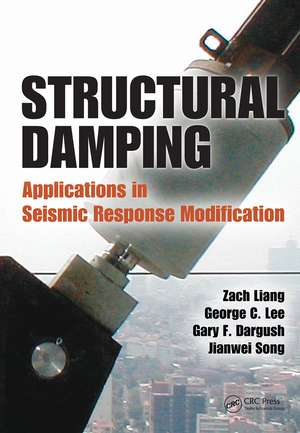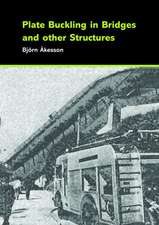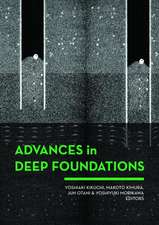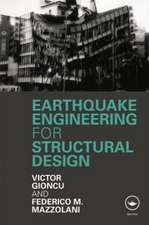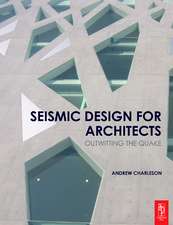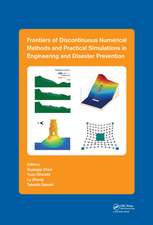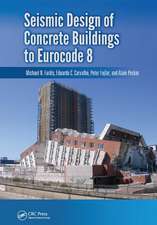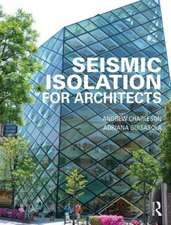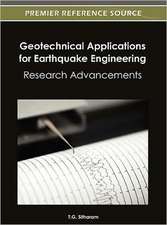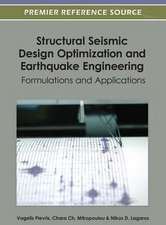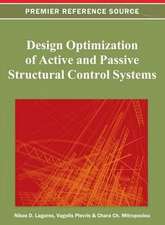Structural Damping: Applications in Seismic Response Modification: Advances in Earthquake Engineering
Autor Zach Liang, George C. Lee, Gary F. Dargush, Jianwei Songen Limba Engleză Hardback – 21 noi 2011
Taking a different approach, Structural Damping: Applications in Seismic Response Modification considers the dynamic responses of structures with added damping devices as systems governed by the combined effect of the static stiffness, period, and damping—or "dynamic stiffness"—of the structure-device system. This formulation supplies additional information for higher-level supplemental damping design that current provisions may not adequately cover. The authors also propose a more comprehensive consideration of the core issues in structural damping, which provides a useful foundation for continued research and development in seismic response modification technologies for performance-based engineering.
The book includes design examples, based on the authors’ research and practical experience, to illustrate approaches that include higher-level supplemental damping to complement the use of the current NEHRP/ASCE-7 provisions. A self-contained resource on damping design principles, this book helps earthquake engineers select the most effective type of damper and determine the amount and configuration of damping under given working conditions.
Preț: 1137.27 lei
Preț vechi: 1386.90 lei
-18% Nou
Puncte Express: 1706
Preț estimativ în valută:
217.64€ • 236.33$ • 182.82£
217.64€ • 236.33$ • 182.82£
Carte tipărită la comandă
Livrare economică 22 aprilie-06 mai
Preluare comenzi: 021 569.72.76
Specificații
ISBN-13: 9781439815823
ISBN-10: 1439815828
Pagini: 581
Ilustrații: 136 b/w images, 68 tables and 1856
Dimensiuni: 178 x 254 x 30 mm
Greutate: 1.26 kg
Ediția:New.
Editura: CRC Press
Colecția CRC Press
Seria Advances in Earthquake Engineering
Locul publicării:Boca Raton, United States
ISBN-10: 1439815828
Pagini: 581
Ilustrații: 136 b/w images, 68 tables and 1856
Dimensiuni: 178 x 254 x 30 mm
Greutate: 1.26 kg
Ediția:New.
Editura: CRC Press
Colecția CRC Press
Seria Advances in Earthquake Engineering
Locul publicării:Boca Raton, United States
Public țintă
Academic and Professional Practice & DevelopmentCuprins
VIBRATION SYSTEMS: Free and Harmonic Vibration of Single-Degree-of-Freedom Systems. Linear Multi-Degree-of-Freedom Systems. Multi-Degree-of-Freedom Systems with General Damping. PRINCIPLES AND GUIDELINES FOR DAMPING CONTROL: Principles of Damper Design. System Nonlinearity and Damping of Irregular Structures. DESIGN OF SUPPLEMENTAL DAMPING: Linear Damping Design. Nonlinear Damping. Index.
Notă biografică
Dr. Zach Liang is a research professor in the Department of Mechanical and Aerospace Engineering at the State University of New York at Buffalo.
Dr. George C. Lee is a SUNY Distinguished Professor in the Department of Civil, Structural and Environmental Engineering at the State University of New York at Buffalo.
Dr. Gary F. Dargush is Professor and Chair of the Department of Mechanical and Aerospace Engineering (MAE) at the State University of New York at Buffalo.
Dr. Jianwei Song is a senior research scientist in the Multidisciplinary Center for Earthquake Engineering Research in the Department of Civil, Structural and Environmental Engineering at the State University of New York at Buffalo.
Dr. George C. Lee is a SUNY Distinguished Professor in the Department of Civil, Structural and Environmental Engineering at the State University of New York at Buffalo.
Dr. Gary F. Dargush is Professor and Chair of the Department of Mechanical and Aerospace Engineering (MAE) at the State University of New York at Buffalo.
Dr. Jianwei Song is a senior research scientist in the Multidisciplinary Center for Earthquake Engineering Research in the Department of Civil, Structural and Environmental Engineering at the State University of New York at Buffalo.
Descriere
This book provides principles and guidelines to help engineers design supplemental damping devices to reduce earthquake-induced structural vibrations—especially when the level of damping is high or when nonlinearities are important design issues. It tackles limitations of conventional design practice and explores how to improve them to handle enhanced damping. The book reviews structural dynamics theory, introduces design principles for commonly used dampers, and explores more detailed procedures based on the classification of specific damping devices according to their linearity. It helps engineers select the most effective type of damper and determine the amount and configuration of damping under given working conditions.
